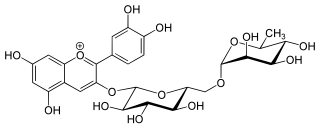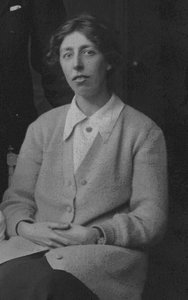
John Burdon Sanderson Haldane, nicknamed "Jack" or "JBS", was a scientist born in Britain who later moved to India and took citizenship there, who worked in physiology, genetics, evolutionary biology, and mathematics. With innovative use of statistics in biology, he was one of the founders of neo-Darwinism. Despite his lack of an academic degree in the field, he taught biology at the University of Cambridge, the Royal Institution, and University College London. Renouncing his British citizenship, he became an Indian citizen in 1961 and worked at the Indian Statistical Institute until his death in 1964.

Antirrhinum is a genus of plants in the Plantaginaceae family, commonly known as dragon flowers or snapdragons because of the flowers' fancied resemblance to the face of a dragon that opens and closes its mouth when laterally squeezed. They are also sometimes called toadflax or dog flower. They are native to rocky areas of Europe, the United States, Canada, and North Africa. Antirrhinum species are widely used as ornamental plants in borders and as cut flowers.

The John Innes Centre (JIC), located in Norwich, Norfolk, England, is an independent centre for research and training in plant and microbial science founded in 1910. It is a registered charity grant-aided by the Biotechnology and Biological Sciences Research Council (BBSRC), the European Research Council (ERC) and the Bill and Melinda Gates Foundation and is a member of the Norwich Research Park. In 2017, the John Innes Centre was awarded a gold Athena SWAN Charter award.

Jeffrey Barry Harborne FRS was a British chemist who specialised in phytochemistry. He was Professor of Botany at the University of Reading, 1976–93, then Professor emeritus. He contributed to more than 40 books and 270 research papers and was a pioneer in ecological biochemistry, particularly in the complex chemical interactions between plants, microbes and insects.

Antirrhinum majus, the common snapdragon, is a species of flowering plant belonging to the genus Antirrhinum. The plant was placed in the family Plantaginaceae following a revision of its prior classical family, Scrophulariaceae.

Biological pigments, also known simply as pigments or biochromes, are substances produced by living organisms that have a color resulting from selective color absorption. Biological pigments include plant pigments and flower pigments. Many biological structures, such as skin, eyes, feathers, fur and hair contain pigments such as melanin in specialized cells called chromatophores. In some species, pigments accrue over very long periods during an individual's lifespan.
Pigmentation disorders are disturbances of human skin color. There may be a loss or reduction, which may be related to loss of melanocytes or the inability of melanocytes to produce melanin or transport melanosomes correctly.
The one gene–one enzyme hypothesis is the idea that genes act through the production of enzymes, with each gene responsible for producing a single enzyme that in turn affects a single step in a metabolic pathway. The concept was proposed by George Beadle and Edward Tatum in an influential 1941 paper on genetic mutations in the mold Neurospora crassa, and subsequently was dubbed the "one gene–one enzyme hypothesis" by their collaborator Norman Horowitz. In 2004, Horowitz reminisced that "these experiments founded the science of what Beadle and Tatum called 'biochemical genetics.' In actuality they proved to be the opening gun in what became molecular genetics and all the developments that have followed from that." The development of the one gene–one enzyme hypothesis is often considered the first significant result in what came to be called molecular biology. Although it has been extremely influential, the hypothesis was recognized soon after its proposal to be an oversimplification. Even the subsequent reformulation of the "one gene–one polypeptide" hypothesis is now considered too simple to describe the relationship between genes and proteins.

Primulin is an anthocyanin. It is the 3-galactoside of malvidin. It can be found in Primula sinensis.

Antirrhinin is an anthocyanin. It is the 3-rutinoside of cyanidin.

Blue tomatoes, also called purple tomatoes, are tomatoes that have been bred to produce high levels of anthocyanins, a class of pigments responsible for the blue and purple colours of many fruits, including blueberries, blackberries and chokeberries. Anthocyanins may provide protection for the plant against insects, diseases, and ultraviolet radiation. Some of these tomatoes have been commercialized under the names "Indigo Rose" and "SunBlack".

Muriel Onslow was a British biochemist, born in Birmingham, England. She studied the inheritance of flower colour in the common snapdragon Antirrhinum and the biochemistry of anthocyanin pigment molecules. She attended the King Edward VI High School in Birmingham and then matriculated at Newnham College, Cambridge in 1900. At Cambridge she majored in botany. Onslow later worked within William Bateson's genetic group and then Frederick Gowland Hopkins' biochemical group in Cambridge, providing her with expertise in biochemical genetics for investigating the inheritance and biosynthesis of petal colour in Antirrhinum. She was one of the first women appointed as a lecturer at Cambridge, after moving to the Biochemistry department.

Enrico Sandro Coen is a British biologist who studies the mechanisms used by plants to create complex and varied flower structures. Coen's research has aimed to define the developmental rules that govern flower and leaf growth at both the cellular level and throughout the whole plant to better understand evolution. He has combined molecular, genetic and imaging studies with population and ecological models and computational analysis to understand flower development.

Catherine Rosemary Martin is a Professor of Plant Sciences at the University of East Anglia (UEA) and project leader at the John Innes Centre, Norwich, co-ordinating research into the relationship between diet and health and how crops can be fortified to improve diets and address escalating chronic disease globally.

Florence Margaret Durham was a British geneticist at Cambridge in the early 1900s and an advocate of the theory of Mendelian inheritance, at a time when it was still controversial. She was part of an informal school of genetics at Cambridge led by her brother-in-law William Bateson. Her work on the heredity of coat colours in mice and canaries helped to support and extend Mendel's law of heredity. It is also one of the first examples of epistasis.
Harry Harris FRS, FCRP was a British-born biochemist. His work showed that human genetic variation was not rare and disease-causing but instead was common and usually harmless. He was the first to demonstrate, with biochemical tests, that with the exception of identical twins we are all different at the genetic level. This work paved the way for many well-known genetic concepts and procedures such as DNA fingerprinting, the prenatal diagnosis of disorders using genetic markers, the extensive heterogeneity of inherited diseases, and the mapping of human genes to chromosomes

Alison Mary Smith is a British biologist. She is Strategic Programme Leader at the John Innes Centre in Norwich and an Honorary Professor at the University of East Anglia (UEA) in the UK.
Rosemary Carpenter is a British plant geneticist known for her work on members of the genus Antirrhinum, commonly known as a snapdragon, for which she and Enrico Coen were awarded the 2004 Darwin Medal by the Royal Society.
Alice Elizabeth Gairdner (1873–1954) was a British plant scientist, geneticist and cytologist.













